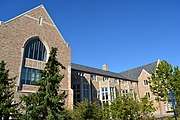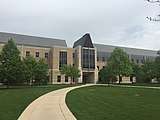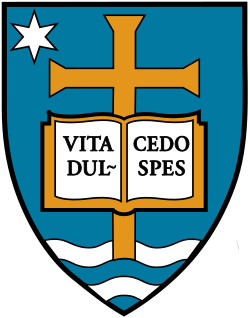Mendoza College of Business
The Mendoza College of Business is the business school at the University of Notre Dame, a private in Notre Dame, Indiana. Founded in 1921, it offers both undergraduate and graduate degrees. It is ranked among the top 30 business schools in the United States for graduate and MBA programs. A part from its main campus, it also offers an executive MBA in Chicago. The school was renamed in 2000 following a donation to the school by Tom Mendoza.
 | |
| Type | Private Catholic (Congregation of Holy Cross) |
|---|---|
| Established | 1921 |
| Affiliation | AACSB |
| Dean | Martijn Cremers |
Academic staff | 131 (2018) |
| Students | 2,325 (2018) |
| Undergraduates | 1,700 (2018) |
| Postgraduates | 625 (2018) |
| Location | , , 41°41′49.23″N 86°14′8.77″W |
| Website | business |
 | |
History
Business and commerce classes had been taught at Notre Dame since its foundation, and already in 1853 there was a Mercantile Department. The teaching of business was yet fragmented for many years, with the Department disappering from 1856 to 1860, and then being reformulated as a Two-year Commercial Course in 1863. This course taught Book-keeping, Penmanship, Arithmetic, Algebra, English Grammar and Composition, Elocution, Geography, History, German, Business Practice, and Commercial Law and was stable for several years. In 1905, it was renamed Commercial School and it became a one-year program. In 1910 meanwhile, the program was inserted into the preparatory school curriculum and became a for year course. Meanwhile, in 1913, a proper Department of Commerce was established within the College of Arts and Letters. This included several courses on secretarial and business work but also training for managerial and executive positions. The main program offered was a four-year Bachelor of Philosophy in Commerce, with classes in accounting for four semesters, with additional classes in money, credit and banking, public finance, economic development in the United States, railway transportation, industrial organization and combination, insurance, and Business Law. Additional coursework included several foreign languages, economics, philosophy, politics, labor problem, American government, and elocution.[1] In 1917, Notre Dame became the first university to launch a four-year course in Foreign Commerce.[2]
The real beginning of the school was on April 20, 1921, when the department was removed from the College of Arts and Letters and became the separate College of Commerce. The first dean of the college was John Francis O'Hara (who later became the president of the University and a Cardinal). O'Hara (who himself had spearheaded the new Foreign Commerce) was inspired by his knowledge of business (he had studied at Wharton and of the history and culture Latin America (where he had lived following his ambassador father). He hoped to place Notre Dame and its graduates in the burgeoning trade and growing economic power between North and South America. In 1921, the college had about 400 students and 13 faculty. Under O'Hara's diligent leadership, the school soon offered 85 classes in 5 departments (accounting, marketing, transportation, finance, foreign trade) and his efforts, together with a societal trend towards valuing business education to obtain a job, made the College tie the College of Arts and Letters as the most numerous already in 1922, with over 500 students. Despite the criticism that the college's education was becoming too commercialized and vocational, O'Hara still maintained a liberal arts theme in the business courses and retained language, philosophy, political science, and history classes. O'Hara'ambitious goals (which included a graduate school and major program in foreign commerce) were cut short by lack of funding.[3]
In 1924, James E. McCarthy succeeded O'Hara as Dean, a post he would keep till in 1955. McCarthy, who was born in Holyoke in 1896 and graduated from Columbia in 1916, was an outspoken advocate of free trade and was well acquainted with many of the nation's leading businessmen and CEOs. During his tenure, the College rose greatly in prominence and visibility, hugely increased its number and quality of courses, and became the University's largest academic division increasing from 500 to 1500 students.[4] In 1933, Chicago businessman Edward N. Hurley donated $200,000 for a new building for the college, which was named Hurley Hall.[5] O'Hara had been pursuing Hurley for such donation since 1919, but the financial situation of the country had not permitted it. Hurley was a successful businessman, founder of the Hurley Machine Company, and chairman of the Federal Trade Commission and the U.S. Shipping Board. He had been the honorary Dean of the College since its founding and had received the Laetare Medal in 1926.[6]
Roger Huang, Martin J. Gillen Dean and Kenneth R. Meyer Professor of Global Investment Management, joined the college in 2000. In March 2000, the College of Business received a naming gift from NetApp, Inc. executives, Tom and Kathy Mendoza.
Rankings and reputation
| Business school rankings | |
|---|---|
| Worldwide overall | |
| QS[7] | 89 |
| Worldwide MBA | |
| Economist[8] | 49 |
| Financial Times[9] | 58 |
| U.S. MBA | |
| Bloomberg Businessweek[10] | 22 |
| Forbes[11] | 26 |
| U.S. News & World Report[12] | 26 |
| U.S. undergraduate | |
| Bloomberg Businessweek[13] | 2 |
| U.S. News & World Report[14] | 11 |
In 2016, Mendoza's undergraduate business program was ranked No. 2 by Bloomberg Businessweek. Mendoza's undergraduate business program was ranked No. 9 in the U.S. by U.S. News in 2016. In the 2017 edition, Mendoza no longer appears among the top 10.[15] However, in 2017, Poets and Quants ranked Mendoza's undergraduate business program at No. 4 nationally.[16]
Rankings for Mendoza's MBA program among U.S. MBA programs include #22 by Forbes, #26 in 2017 by Bloomberg BusinessWeek and #31 by US News and World Report. In global rankings, the Mendoza MBA was ranked #40 by The Economist and #80 by Financial Times. Its Executive MBA program was ranked #15 by Bloomberg Businessweek.[10] College Atlas and The Economist rank the Mendoza MBA 2nd among business schools in Indiana.[17][18]
For 2011, the Aspen Institute, which ranks institutions on how well schools incorporate issues concerning social and environmental stewardship into the curriculum, ranked Mendoza #4 worldwide.[19]
Poets & Quants reveals a placement rate of 93% after 3 months for the Undergraduate school, as well as an average starting salary of roughly $61,000.[20]
Selectivity
MBA program
The admissions rate for the 2014 was 35%. Applicants are required to take the GMAT exam. Of the admitted applicants, the median score was 687 and the middle 80% of scores ranged from 650 to 769.[21]
Undergraduate program
After completing the university's First Year of Studies program, Notre Dame business majors enter the Mendoza College in their sophomore year. Starting in 2015, high school applicants will have to apply directly and be "pre-approved" for admission into Mendoza after their first year of studies.[22]
Executive Education
Stayer Center for Executive Education offers degree programs and non-degree programs for full-time working professionals. In addition to the programs offered at the Notre Dame campus in South Bend and the campus in Chicago, Illinois, there is also a program that takes place in Ireland.[23]
Facilities
 Stayer Center, home of the Executive MBA and other programs.
Stayer Center, home of the Executive MBA and other programs. Stayer Center of Executive Education on the historic campus of the University of Notre Dame.
Stayer Center of Executive Education on the historic campus of the University of Notre Dame._Building.jpg) The Motorola Building in Chicago, home to the MBA program in Chicago
The Motorola Building in Chicago, home to the MBA program in Chicago Potenziani Family Atrium at the Mendoza College of Business with a NYSE trading post
Potenziani Family Atrium at the Mendoza College of Business with a NYSE trading post Mendoza College of Business from DeBartolo Quad
Mendoza College of Business from DeBartolo Quad
See also
References
- Moore, Philip (1960). "Academic Development of Notre Dame: 4". archives.nd.edu. Retrieved 14 June 2020.
- Kerry, Temple. O'Hara Heirs: Business Education at Notre Dame 1921-1991. Notre Dame, Indiana 46556: College of Business Administration. p. 6.CS1 maint: location (link)
- Kerry, Temple. O'Hara Heirs: Business Education at Notre Dame 1921-1991. Notre Dame, Indiana 46556: College of Business Administration. p. 16.CS1 maint: location (link)
- Kerry, Temple. O'Hara Heirs: Business Education at Notre Dame 1921-1991. Notre Dame, Indiana 46556: College of Business Administration. p. 12.CS1 maint: location (link)
- "September 2002". www.irishlegends.com. Retrieved 14 June 2020.
- Kerry, Temple. O'Hara Heirs: Business Education at Notre Dame 1921-1991. Notre Dame, Indiana 46556: College of Business Administration. p. 12.CS1 maint: location (link)
- "QS Global MBA Rankings 2020". Quacquarelli Symonds. Retrieved 26 September 2019.
- "Full time MBA ranking". The Economist. 2019. Retrieved 27 January 2020.
- "Global MBA Ranking 2020". Financial Times. Retrieved 27 January 2020.
- "Best B-Schools". Bloomberg Businessweek. 8 November 2018. Retrieved 25 September 2019.
- "The Best Business Schools". Forbes. 2019. Retrieved 25 September 2019.
- "2019 Best Business Schools Rankings". U.S. News & World Report. Retrieved 25 September 2019.
- "The Complete Ranking: Best Undergraduate Business Schools 2016". Bloomberg Businessweek. Retrieved 25 September 2019.
- "2019 Best Undergraduate Business Programs Rankings". U.S. News & World Report. Retrieved 25 September 2019.
- "Best Undergraduate Business Schools 2017". U.S. News and World Report.
- Allen, Nathan (5 December 2017). "Wharton Tops Poets&Quants' Best Undergraduate Business Programs Of 2017". Poets&Quants for Undergrads.
- "Best Business Schools in Indiana". CollegeAtlas.
- "Mendoza MBA Worldwide ranking". The Economist.
- "Rankings: Top Ten Lists". The Aspen Institute. Retrieved 28 October 2011.
- "Mendoza Information". Poets and Quants.
- "University of Notre Dame: Mendoza College of Business - Full-Time MBA Profile". Businessweek. Retrieved 12 February 2016.
- "Notre Dame to Adjust Admission Practices for Prospective Business Undergraduates // News // Enrollment Division // University of Notre Dame". enrollmentdivision.nd.edu.
- "Executive Education - Notre Dame Business". Mendoza College of Business.
